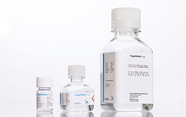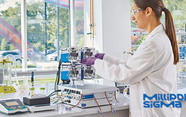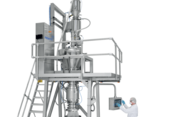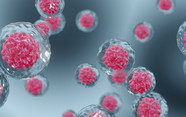Understanding Mass Spectrometry for Biologics
As biologics become more complex, mass spec becomes more indispensable than ever in the drug developer’s toolbox.
Chris Nortcliffe | | 9 min read

Small molecule drugs continue to dominate the drug pipeline in volume terms, but biologic therapeutics are an alternative, and increasingly important, therapeutic class. Within biologics, a growing number of novel modalities are now emerging, with next-generation biologics incorporating the already heterogeneous features that are present in monoclonal antibodies (mAbs) and other proteins, and adding new layers of molecular complexity.
The added intricacy of these molecular moieties and characteristics means the number of critical quality attributes (CQAs) that need to be monitored is increasing. Newer analytical methods are therefore required to ensure the purity and characteristics of the drugs, resulting in safe and efficacious medicines. Here, mass spectrometry (MS) is used extensively in small molecule drug development and is cementing its place as an indispensable tool in biologics development and manufacturing.
The role of MS
The reason that MS plays such a critical role in biologics is because of the depth and breadth of information that can be drawn from it as a standalone method, or to augment information gained by other methods. In part, this is because of the compatibility of various chromatography methods with MS, making it suitable for bioanalytical processes such as size-exclusion and charge variance. Additionally, MS can be employed early in the development process, enabling the monitoring of many CQAs, and allowing process development and optimization to focus on the final product profile. In other words: Quality by Design (QbD).
The most basic application of MS for biologics is the determination of a protein’s amino acid sequence and expected mass to ensure that the protein has been expressed correctly. The availability and improvement of chromatography phases and sensitive instrumentation have made this process routine and quick. In addition, these peptide mapping experiments allow the determination of both the presence and location of any post-translational modifications (PTMs), such as oxidation and deamidation on the protein during production and purification. Sequence variants present in a protein population, which may be the result of DNA mutations and the incorrect incorporation of one or more amino acids, can also be elucidated with the correct software.
A newer approach, multi-attribute monitoring (MAM), is becoming more widely used to monitor a variety of CQAs in a single liquid chromatography-mass spectrometry experiment. The aim of MAM is to streamline a number of analytical processes, such as the identification of amino acid sequence and PTMs, and allow for the generation of more comparable data from upstream through to quality control.
With newer technologies moving analytics alongside manufacturing, MAM can be utilized “at-line,” especially with the move towards continuous production systems. Processing decisions can be made based on real-time data to ensure that every batch meets the CQA profile; an example of QbD in action.
Disulfide analysis and structural analysis
Mass spectrometry is increasingly being used as a tool in structural biology thanks to the development of hybrid techniques that allow more information to be extracted than mass measurements and structural identification.
The first, and currently most widespread, is assigning disulfide bonds present within a protein. Disulfide bonds are chemical links between cysteine amino acids in a single chain, or in different chains of a protein, and their correct formation is usually essential in protein structure, function and stability. Cleaving a protein under conditions that retain disulfide bonds allows MS to determine their position(s), and identify which peptides remain linked together. Purification, chemical modification or stress can result in temporary breakage of these bonds, which may then re-form in incorrect positions, resulting in disulfide bond scrambling. This can lead to protein aggregation and reduced efficacy.
Ion-mobility mass spectrometry is being deployed more frequently in biologics development as the required equipment is now commercially available. This technique allows the collisional cross-section of molecules to be measured in the gas phase, providing a measure of the structure and shape. These experiments can uncover information about stability, stress induced unfolding, and conformational changes.
Hydrogen-deuterium exchange (HDX) mass spectrometry is another technique that is moving into the mainstream, with the application of robotic-assisted sample handling and online digestion. HDX incubates folded proteins with deuterium, which exchanges with surface-accessible hydrogens. The degree and location of the changes provides a measure of which hydrogens are most exposed.
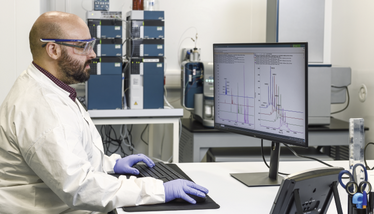
Impurities and HCP analysis
Mass spectrometry has a long history of impurity profiling in traditional pharmaceuticals, and biologics is no exception despite the very different chemistry. With the adoption of single-use plastics in upstream production, it is important to identify the presence of any extractables and leachables being released from any surfaces the molecule or solution may have been in contact with. Non-volatile compounds can be monitored through the combination of liquid chromatography with MS, whereas gas chromatography can detect volatile compounds, and inductively coupled plasma can profile heavy metals.
Protein contamination can come in the form of host cell proteins (HCPs) released from cellular expression. Very low residual amounts of HCPs can be difficult to detect or identify, but may elicit an immune response in patients. Three of the key issues with strategies to measure HCPs are specificity, sensitivity and dynamic range. The impurity proteins are only present at very low concentrations in the drug substance material compared to the biologic itself. MS can provide greater specificity and quantification than earlier methods such as enzyme-linked immunosorbent assays (ELISAs).
ADCs and analytical challenges
Antibody-drug conjugates (ADCs) are made up of three components: a cytotoxic agent, commonly referred to as a “warhead,” which is attached to a mAb through a chemical linker. Because of the cytotoxic nature of the payloads, specialized laboratories and protocols are required to ensure these materials are handled safely.
As of May 2024, 13 ADCs had gained marketing approval by the FDA, and there are many more in clinical trials. ADCs present significant analytical challenges because of the inherent heterogeneity of the mAb scaffolds, combined with varying numbers of drug moieties conjugated to already-complex biologics.
Payloads (the linker plus toxin) can be generally split into two categories, based on whether the connecting linker is cleavable or not. Cleavable linkers will release the toxin under specific conditions such as within particular tumor microenvironments or within cells; non-cleavable linkers require the complete breakdown of the protein within lysosomes. Before conjugation, MS can be used to ensure these linkers cleave as expected, using either isolated enzymes or biological fluids such as cell extracts. Although chromatography may be able to detect changes in retention time and the payload splitting into two, mass spectrometry can resolve down to the specific molecular species after cleavage.
Connecting antibodies to small molecules can be a difficult process, involving optimizing the buffer solutions and reaction conditions without destabilizing the protein. The key output from this process is the drug-antibody ratio (DAR), which specifies the number of drug molecules that are present per antibody. As this is a very important factor in both efficacy and safety, it is critical to have a known and reproducible number attached to each protein for dosing.
Analytical methods must be capable of analyzing both the protein and the toxin-plus-linker. MS can be very useful because of its ability to analyze both, and can characterize molecules that may not separate well by chromatography.
Methods for measuring DAR can vary depending upon the chemistry used to attach the drugs. Lysine addition is random, as it can occur at a variety of sites across the antibody, resulting in complex mixtures. Cysteine conjugations, in contrast, are added at known disulfide bonds or engineered sites in a more reproducible fashion. However, this breaks the covalent bonds holding the antibody together, making analysis via denaturing techniques problematic. The disulphide bonds can be re-formed incorrectly, and measurements of scrambling may also be required.
Hydrophobic interaction chromatography has proved a useful tool when the conjugation uses cysteine because it relies on the hydrophobic nature of the payloads. However, it is not universally suitable for lysine conjugations or when shielded and hydrophilic linkers are used. Reverse-phase chromatography has been used to measure the DAR after reduction to light and heavy chains. However, when there are unexpected peaks or linkers that do not result in a clear shift, it does not give clear results. Mass spectrometry can be highly effective in these situations, as the mass shifts upon conjugation are clear even when chromatographic separation is difficult. By using size-exclusion chromatography in combination with MS, non-covalent interactions can be retained, providing accurate DAR analysis when the disulphide bonds have been removed.
After conjugation and DAR confirmation methods, drug additions can be treated as post-translational modifications and analyzed using MS sequencing methods. After tryptic digestions, peptides modified with payloads can be separated from the unmodified peptides based on their hydrophobicity and then detected using their mass shift. Traditional fragmentation methods cannot always localize modifications down to a single amino acid as the payloads often break apart first. However, more modern commercially available methods such as electron capture dissociation can provide more specific information in these instances.
Newer conjugation strategies result in “activated” antibody intermediates, to which toxic payloads are added to specific sites on the linker. Often, the differences of these activated intermediates are so subtle from the parent antibody that they cannot be detected via chromatography alone. However, the application of MS in process development allows these reactions to be monitored to optimize conjugation conditions.
After the ADC has been conjugated and the DAR measured, it can go on to further stability and stress studies where MS can determine if the payloads are being lost or breaking down. When moving to pharmacokinetic and absorption, distribution, metabolism and excretion experiments, MS can be used as an alternative to ELISAs to measure the amount of conjugated and unconjugated antibody.
As with any method of analysis, there is no single tool that is appropriate for all biologics. The skill of the analyst is in choosing complementary techniques that give the broadest possible amount of information to ensure drug quality. Mass spectrometry is a powerful and well-understood tool that has many applications within this field, alongside other methods such as chromatography and ELISA to provide the information required by regulators to support the manufacturing processes for these drugs. As the biopharmaceutical field continues to evolve and grow, mass spectrometry is well-positioned to support development to safely deliver complex new therapeutics to patients from peptides, to ADCs and beyond.
Mass Spectrometry Manager, Sterling Pharma Solutions








